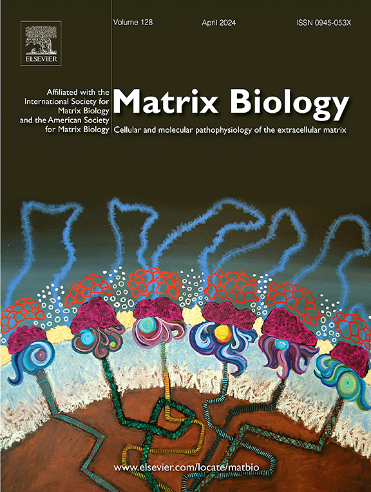Around the collagen triple helix: an introduction to studying associated genetic and acquired diseases
IF 4.8
1区 生物学
Q1 BIOCHEMISTRY & MOLECULAR BIOLOGY
引用次数: 0
Abstract
The triple helix structure of collagen is the most abundant motif found in our bodies. It is believed to have emerged during the transition from unicellular to multicellular animal organisms, known as metazoans, and has evolved into various proteins that contribute to the development and function of diverse animal tissues, organs, and systems. Once synthesized, these collagenous proteins undergo post-translational modifications and proper folding inside the cell, after which they primarily function outside the cell. Over 80 collagenous proteins are categorized into two main groups: collagens and collagen-like proteins. However, the distinction between these groups is not clearly defined. Within these categories, there are various types of proteins, including soluble proteins, transmembrane proteins, and those that form the extracellular matrix. Multiple genetic diseases highlight the significance of collagenous proteins, which can be affected by defects in their primary structure, post-translational modifications, or complete loss. While fixing the gene defect may seem like a straightforward solution, we currently lack the capability to do so. Moreover, acquired diseases caused or accompanied by adverse processes in the collagen triple helix are generally not suitable for gene therapy at all. Understanding the pathogenicity of a defective polypeptide chain can provide valuable insights into strategies for mitigating negative consequences for both genetic and acquired diseases. This review highlights the current state of research in the collagen triple helix field, offering insights into how to study specific defects and deepen our understanding of their underlying pathogenic mechanisms.
围绕胶原蛋白三螺旋:介绍研究相关的遗传和获得性疾病。
胶原蛋白的三螺旋结构是我们体内发现的最丰富的基序。它被认为是在从单细胞动物有机体向多细胞动物有机体过渡的过程中出现的,被称为后生动物,并已进化成各种蛋白质,这些蛋白质有助于各种动物组织、器官和系统的发育和功能。一旦合成,这些胶原蛋白在细胞内进行翻译后修饰和适当折叠,之后它们主要在细胞外发挥作用。超过80种胶原蛋白被分为两大类:胶原蛋白和胶原样蛋白。然而,这些群体之间的区别并没有明确界定。在这些类别中,有各种类型的蛋白质,包括可溶性蛋白质,跨膜蛋白质和那些形成细胞外基质的蛋白质。多种遗传疾病突出了胶原蛋白的重要性,胶原蛋白可能受到其初级结构缺陷、翻译后修饰或完全丢失的影响。虽然修复基因缺陷似乎是一个直截了当的解决方案,但我们目前缺乏这样做的能力。此外,由胶原蛋白三螺旋不良过程引起或伴随的获得性疾病,一般根本不适合进行基因治疗。了解缺陷多肽链的致病性可以为减轻遗传和获得性疾病的负面后果提供有价值的见解。本文综述了胶原蛋白三螺旋领域的研究现状,为如何研究特定缺陷和加深对其潜在致病机制的理解提供了新的见解。
本文章由计算机程序翻译,如有差异,请以英文原文为准。
求助全文
约1分钟内获得全文
求助全文
来源期刊

Matrix Biology
生物-生化与分子生物学
CiteScore
11.40
自引率
4.30%
发文量
77
审稿时长
45 days
期刊介绍:
Matrix Biology (established in 1980 as Collagen and Related Research) is a cutting-edge journal that is devoted to publishing the latest results in matrix biology research. We welcome articles that reside at the nexus of understanding the cellular and molecular pathophysiology of the extracellular matrix. Matrix Biology focusses on solving elusive questions, opening new avenues of thought and discovery, and challenging longstanding biological paradigms.
 求助内容:
求助内容: 应助结果提醒方式:
应助结果提醒方式:


